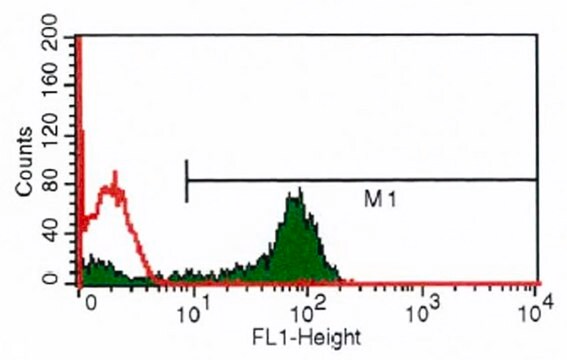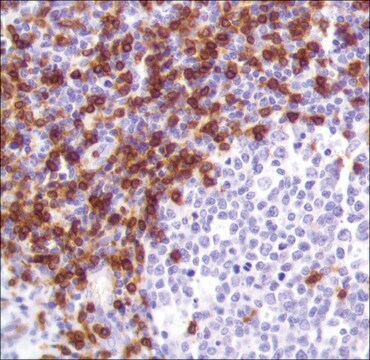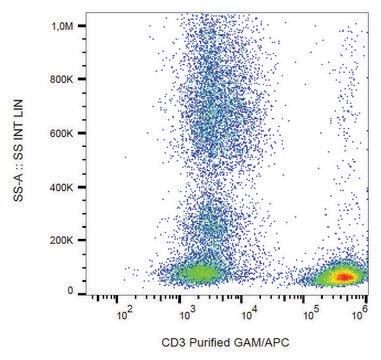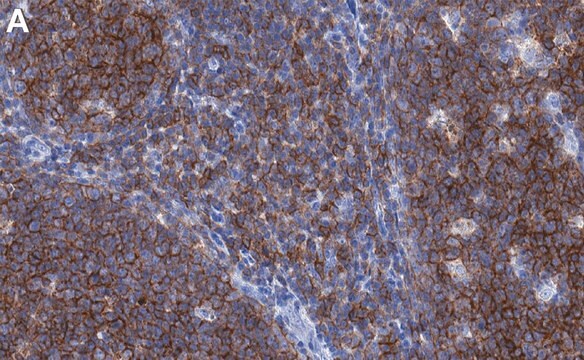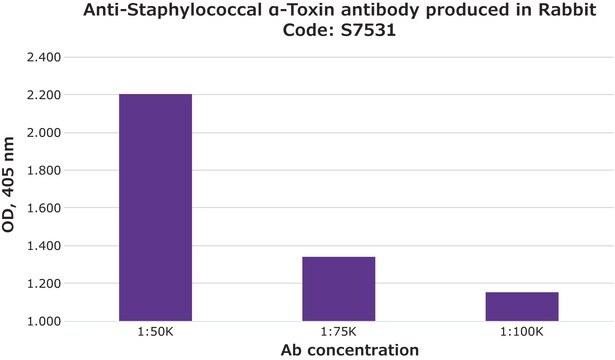추천 제품
생물학적 소스
mouse
Quality Level
결합
unconjugated
항체 형태
purified immunoglobulin
항체 생산 유형
primary antibodies
클론
UCHT-1, monoclonal
양식
buffered aqueous solution
종 반응성
human
기술
flow cytometry: 5 μL using 1 × 106 cells
동형
IgG1
UniProt 수납 번호
배송 상태
wet ice
저장 온도
2-8°C
타겟 번역 후 변형
unmodified
유전자 정보
human ... CD3E(916)
유사한 제품을 찾으십니까? 방문 제품 비교 안내
특이성
Recognizes the CD3 complex. The epitope recognized by clone no. UCHT-1 is expressed on the ε-chain of the CD3 antigen/T cell receptor complex. 3rd Workshop: code no. 126, 208 and 471
4th Workshop: paper no. T3.2
4th Workshop: paper no. T3.2
면역원
human thymocytes followed by Sezary T cells.
애플리케이션
Monoclonal Anti-CD3 antibody produced in mouse is suitable for flow cytometry at a dilution of 5μL using 1 × 106 cells.
생화학적/생리학적 작용
The CD3e cytoplasmic domain of the T cell receptor binds to the inner leaflet of the plasma membrane (PM) and is accessible during early stages of T cell activation. It is specific for T lymphocytes, found in Purkinje cells of the cerebellum and gastric parietal cells of humans and other species. The antibodies commonly used to recognize CD3 are directed against the ε-subunit of the T cell receptor. Cytoplasmic cyCD3 expression can only be achieved during the early phase of NK-cell differentiation.
표적 설명
The CD3 complex (16/20/29/22/25-28 kDa) consists of 5 polypeptide chains associated with each other and with the T cell receptor.
물리적 형태
Solution in 0.01 M phosphate buffered saline, pH 7.4, containing 1% bovine serum albumin and 15 mM sodium azide.
면책조항
Unless otherwise stated in our catalog or other company documentation accompanying the product(s), our products are intended for research use only and are not to be used for any other purpose, which includes but is not limited to, unauthorized commercial uses, in vitro diagnostic uses, ex vivo or in vivo therapeutic uses or any type of consumption or application to humans or animals.
적합한 제품을 찾을 수 없으신가요?
당사의 제품 선택기 도구.을(를) 시도해 보세요.
Storage Class Code
10 - Combustible liquids
WGK
nwg
Flash Point (°F)
Not applicable
Flash Point (°C)
Not applicable
Francesco Dieli et al.
The Journal of infectious diseases, 186(12), 1835-1839 (2002-11-26)
Vgamma9/Vdelta2 T cells can contribute to protective immune response against Mycobacterium tuberculosis, although the extent to which and mechanisms by which they could actually protect against human tuberculosis remain unclear. We have previously reported that Vgamma9/Vdelta2 T cells from tuberculin
Magda De Smedt et al.
Blood, 110(7), 2696-2703 (2007-07-17)
It has been proposed that heterogeneity in natural killer (NK)-cell phenotype and function can be achieved through distinct thymic and bone marrow pathways of NK-cell development. Here, we show a link between Notch signaling and the generation of intracellular CD3epsilon
Joseph Alroy et al.
Pathology, research and practice, 201(12), 803-808 (2005-11-26)
CD3 antigen, formerly thought to be specific for T lymphocytes, has been identified in Purkinje cells of the cerebellum and gastric parietal cells in several species, including humans. The antibodies commonly used to recognize CD3 are directed against the epsilon-subunit
Luciën E P M van der Vlugt et al.
The Journal of infectious diseases, 210(8), 1207-1216 (2014-05-06)
Chronic schistosome infections are associated with T-cell hyporesponsiveness and a strong regulatory network. Murine studies have shown that schistosome infections can induce regulatory CD1d(hi) B cells, which inhibit inflammatory responses. Here, we evaluated the influence of regulatory B cells (Bregs)
Rinat Sharir et al.
Cardiovascular research, 103(4), 585-596 (2014-06-27)
Ischaemic damage is associated with up-regulation of pro-inflammatory cytokines, as well as invasion of leucocytes and lymphocytes to the injured muscle. Regulatory T cells (Tregs) exert suppressive effects on several immune and non-immune cellular elements. We hypothesized that adoptive Treg
자사의 과학자팀은 생명 과학, 재료 과학, 화학 합성, 크로마토그래피, 분석 및 기타 많은 영역을 포함한 모든 과학 분야에 경험이 있습니다..
고객지원팀으로 연락바랍니다.
